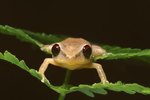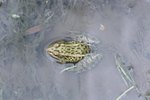North Africa's Sahara Desert is home to its fair share of diverse animals, from dromedary camels to ostriches and seemingly countless others in between. Frogs also often take up residence in the region -- specifically Sahara frogs (Pelophylax saharicus). These family Ranidae frogs are prevalent throughout the northern region of Africa, across the borders of many different countries. Sahara frogs are pretty sizable amphibians.
Sahara Frog Appearance
Sahara frogs are capable of achieving body lengths of just over 4 inches from the vent to the snout, according to AmphibiaWeb of the University of California at Berkeley. Like their fellow members of the family Ranidae, Sahara frogs typically possess lengthy, slender legs and very level and even skin. Family Ranidae species are frequently referred to as "true frogs." Other examples of these frogs are northern leopard frogs (Lithobates pipiens), Smith's wrinkled frog (Ingerana tasanae) and the carpenter frog (Rana virgatipes).
Sahara Frog Geography
These North African natives live all over the northern portion of the continent, including in Tunisia, Algeria, Morocco, Egypt and Libya. Through introduction, some Sahara frogs also reside on Spain's Canary Islands, which are situated just slightly northwest of the African continent. Sahara frogs frequently live in the Western Sahara territory's northwestern corner.
Natural Habitat of the Sahara Frog
As far as environment goes, Sahara frogs are extremely adaptable and sturdy amphibians. They can thrive in a wide array of habitat types, including pre-desert, alpine and wetland. For the most part, Sahara frogs are aquatic and usually stay very close to bodies of water such as streams, rivers, ponds, lakes and canals. They can even usually manage in water that is full of defilement.
Population Status
In terms of population, Sahara frogs are not in any urgent danger. In 2009, these amphibians were categorized as a species of "least concern" by the International Union for Conservation of Nature Red List of Threatened Species. Although Sahara frog numbers seem relatively high, consistent and in control overall, they may have some menaces in some areas of their geographic range. Excessive pollution may be an issue for them in certain parts, along with habitat destruction as a result of drought.
References
- Animal Diversity Web: Pelophylax Saharicus - Classification
- AmphibiaWeb: Pelophylax Saharicus
- Marshall University: Ranidae - True Frogs
- Wildlife Journal Junior: Ranidae - True Frogs
- The IUCN Red List of Threatened Species: Pelophylax Saharicus
- Cleveland Museum of Natural History: True Frogs - Family Ranidae





